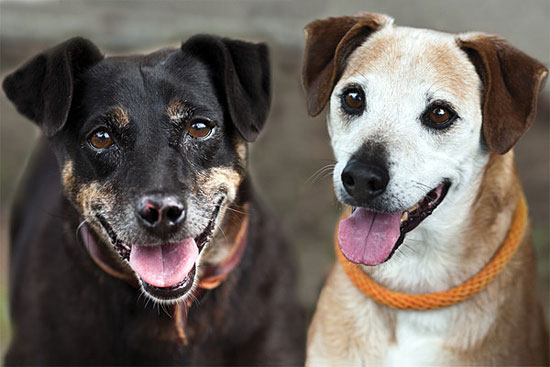A new Rx for our shelter pets
January 31, 2013

These lucky dogs were adopted from L.A. County shelters, where hopes are high because of a new grant.
An injured eye shouldn’t be a death sentence. And yet, such minor medical problems often lead to euthanasia for dogs and cats in animal shelters.
Dr. Maria Sabio-Solacito has been treating animals for 20 years, five of them as head veterinarian for Los Angeles County’s Department of Animal Care and Control. She says she’s seen far too many animals put down when some basic medical treatment could have made them more adoptable.
“Before, the idea was just to grab all the stray dogs and, if no one takes them, euthanize,” said Sabio-Solacito. “Now, we are much more focused on animal care.”
Giving that effort a big boost, the Board of Supervisors on Tuesday approved a $50,000 grant to enhance medical-care capabilities at the county’s six regional shelters, or “animal care centers.”
Limited resources have been the primary challenge for the county’s shelter system, the nation’s largest. Each year, the county is forced to euthanize thousands of cats and dogs. Between July 2011 and June 2012, the agency killed 24,605 cats and 17,745 dogs. (But it also was successful in getting 7,387 cats and 26,942 dogs into adoptive homes or reunited with owners during that period.)
The grant was given to the L.A. County Animal Care Foundation by the American Society for the Prevention of Cruelty to Animals. The foundation is a nonprofit organization that raises funds for the Department of Animal Care and Control and supports spay and neuter programs, pet adoptions, public education and other animal welfare activities in the region.
With the money, the county will purchase eye surgery, dental and blood-testing equipment—resources Sabio-Solacito and her colleagues identified as the most needed and most likely to make the biggest impact. The agency currently contracts with local clinics for those services, an expensive practice that limits how many animals it can treat.
The equipment will enable staff to perform minor surgeries, dental cleanings and offer other vital treatments to sick and injured animals. Eye and dental conditions are highly common in shelters and can lead to serious secondary infections. Shelter officials are optimistic that the new medical services will lead to more adoptions and fewer deaths.
“A lot of animals don’t get adopted just because they have bad teeth,” said Sabio-Solacito. “It’s just because they have been neglected.”
Appearances matter for pups and felines seeking new homes, said Evelina Villa, spokesperson for the county agency. Potential owners shy away from pets with unattractive problems that could require treatment.
“The breath is a big thing too,” she laughed.
For more serious injuries, the Animal Care Foundation funds a program called “Dreams Come True.” Using donations and reduced-rate services from local veterinary schools, even some of the toughest cases of injury or abuse can be treated.
“A huge portion of the animals that come into the shelter were hit by cars,” said Sabio-Solacito. “We used to euthanize. Now we can do surgery or amputations.”
Sabio-Solacito hopes to someday obtain enough funding for a full-service animal medical center, which she’d call “The Second Chance Hospital.” For now, however, she says she’s thrilled with the improvements that are on the way.
“Every little bit of help that we get to properly diagnose and treat conditions makes a huge impact.”
Posted 1/31/13












 405 bridge work causes a stink
405 bridge work causes a stink





